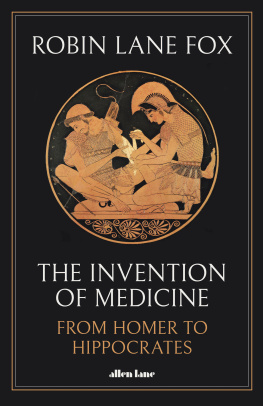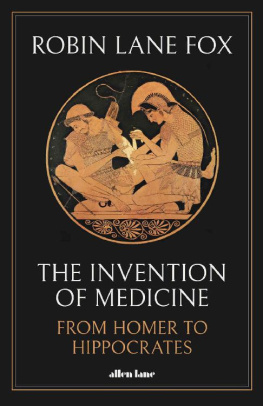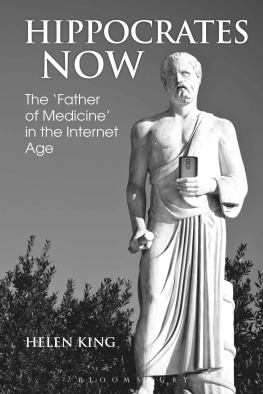Robin Lane Fox - The Invention of Medicine: From Homer to Hippocrates, US Edition
Here you can read online Robin Lane Fox - The Invention of Medicine: From Homer to Hippocrates, US Edition full text of the book (entire story) in english for free. Download pdf and epub, get meaning, cover and reviews about this ebook. year: 2020, publisher: Penguin Books Ltd, genre: Art. Description of the work, (preface) as well as reviews are available. Best literature library LitArk.com created for fans of good reading and offers a wide selection of genres:
Romance novel
Science fiction
Adventure
Detective
Science
History
Home and family
Prose
Art
Politics
Computer
Non-fiction
Religion
Business
Children
Humor
Choose a favorite category and find really read worthwhile books. Enjoy immersion in the world of imagination, feel the emotions of the characters or learn something new for yourself, make an fascinating discovery.
- Book:The Invention of Medicine: From Homer to Hippocrates, US Edition
- Author:
- Publisher:Penguin Books Ltd
- Genre:
- Year:2020
- Rating:3 / 5
- Favourites:Add to favourites
- Your mark:
- 60
- 1
- 2
- 3
- 4
- 5
The Invention of Medicine: From Homer to Hippocrates, US Edition: summary, description and annotation
We offer to read an annotation, description, summary or preface (depends on what the author of the book "The Invention of Medicine: From Homer to Hippocrates, US Edition" wrote himself). If you haven't found the necessary information about the book — write in the comments, we will try to find it.
The Invention of Medicine: From Homer to Hippocrates, US Edition — read online for free the complete book (whole text) full work
Below is the text of the book, divided by pages. System saving the place of the last page read, allows you to conveniently read the book "The Invention of Medicine: From Homer to Hippocrates, US Edition" online for free, without having to search again every time where you left off. Put a bookmark, and you can go to the page where you finished reading at any time.
Font size:
Interval:
Bookmark:
Alexander the Great
Pagans and Christians
The Unauthorized Version: Truth and Fiction in the Bible
The Classical World: An Epic History of Greece and Rome
Travelling Heroes: Greeks and Their Myths in the Epic Age of Homer
Thoughtful Gardening
Augustine: Conversions and Confessions

PENGUIN BOOKS
UK | USA | Canada | Ireland | Australia
New Zealand | India | South Africa
Penguin Books is part of the Penguin Random House group of companies whose addresses can be found at global.penguinrandomhouse.com.

First published by Allen Lane in 2020
Copyright Robin Lane Fox, 2020
The moral right of the author has been asserted
The cover image is an Attic red figure shallow cup, or kylix, that depicts heroic healing. Achilles bandages a pained Patroclus whose foot is braced against the wall, c. 470 BC. Photo Bridgeman Images.
Cover design: Richard Green
ISBN: 978-0-241-27706-5
This ebook is copyright material and must not be copied, reproduced, transferred, distributed, leased, licensed or publicly performed or used in any way except as specifically permitted in writing by the publishers, as allowed under the terms and conditions under which it was purchased or as strictly permitted by applicable copyright law. Any unauthorized distribution or use of this text may be a direct infringement of the authors and publishers rights and those responsible may be liable in law accordingly.
FOR LEO LANE FOX
Medicine is not only a science and an art: it is also a mode of looking at man with a compassionate objectivity. Why turn elsewhere to contemplate mans moral nature?
Owsei Temkin, The Double Face of Janus (1977), 37
The doctor sees terrible things, touches unpleasant ones and reaps a harvest of personal distress from other peoples misfortunes, whereas the sick are turned from the greatest hardships, sicknesses, distress, pain and death thanks to the [medical] craft.
Hippocratic On Breaths, c. 400 BC , 1.1
Book jacket: From an Attic red-figure shallow cup, or kylix, c. 470 BC , in which it is the tondo, or image inside on the bottom, which the drinker would see as he drank the last of his wine mixed with water. Achilles is bandaging the pained Patroclus, and an arrow, probably the source of the wound, is in the ground before him. The episode is not known in Greek poetry: it is discussed on my . An inscription states that Sosias made the cup. The painter is widely known as the Kleophrades painter, while his actual name is still uncertain. Found in the cemetery at Vulci in 1828. Now in the Staatliche Museen zu Berlin, Antikensammlung, inv. no. F 2278.
1. Doctor Iapyx fails to heal Aeneas arrow wound, while Aeneas mother, Venus, appears behind with her cocktail of healing drugs, including Cretan dittany. Aeneas son Ascanius weeps beside him, as in Virgil Aeneid XII.384424; my discusses it. Fresco-painting, c. AD 4560, from the House of P. Vedius Siricus, near the Stabian Baths in Pompeii, Ins.VII.1.25, excavated in 1851. Naples Archaeological Museum, inv. no. 9009.
2. Votive relief in the shape of a small temple, dedicated by Archinos to the healing hero Amphiaraos, at Oropos in north-east Attica, c. 360 BC . From left to right it shows three episodes of divine healing, a widespread resort for the sick from at least the later sixth century BC onwards, but the very opposite of the Hippocratic doctors medicine. The kindly hero (left) leans on his stick and attends a young patient, presumably representing Archinos, and treats his right arm, possibly with a bandage, not a knife. Behind, the right shoulder of the boy, now asleep on a couch, is being licked by a divine snake, related to the healing hero: snakes were also connected with the healing god Asclepius. Behind stands a young worshipper with his right hand raised, surely young Archinos now healed. The plaque, once painted, may have shown the item he dedicated in thanks. Amphiaraos appeared in the dreams of clients who slept in his sanctuary at night and was considered to heal them. Athens, National Archaeological Museum, inv. no. 3369.
3. Recently published fragment on papyrus of an unnamed medical text, found in the town of Oxyrhynchus in Egypt, first to second century AD . It is the first surviving reference by a Greek author to the Hippocratic Oath and to its use in the early training of medical students, but the author implies that the Oath was not used in that way by all medical teachers: for those young men who are being introduced to medicine in a reasoned way it is proper, as I see it at least, in the first place to make the beginning of learning from the Hippocratic Oath [the words are in the third line of the text] since it was established as a most just law and one which is extremely useful for life. For to those who have been initiated through it The words may belong at the beginning of a medical text. They testify to the Oaths continuing fame and its appreciation as most just. They also refer to pupils being initiated, presumably into medicine, a term used in the separate Hippocratic Law, discussed on my . P.Oxy 74.4970.
4. Sculpture of a young male, or kouros, c. 550 BC , inscribed on its right leg with the words Of Som[b]rotidas the doctor son of Mandrocles. It marked his grave. Made of marble from Naxos and imported when already cut into shape, but only partly, as its left arm is not detached from the body. The inscription is in lettering which is probably Samian. Found in the south cemetery of Megara Hyblaea, in Sicily, and discussed on my . Archaeological Museum Paolo Orsi, Syracuse, inv. no. 49401.
5. Silver tetradrachm of Abdera, c. 500475 BC . Obverse depicting a winged griffin and signature of the moneyer in the form of the first four letters of his name: PERI-. My suggest a possible link with the patient Pericles in the city. Paris, Bibliothque nationale de France, inv. no. M1694.
6. Silver drachm of Abdera, c. 475450 BC . Obverse depicting a winged griffin and signature of the moneyer in the form of the first four letters of his name: HERO-. My suggest a possible link with the patient Heropythos in the city. Heberden Coin Room, Ashmolean Museum, Oxford.
7. Marble grave stele, c. 480 BC , showing a bearded doctor, seated, before whom stands a youth, only partially preserved, who is holding a cupping glass in his left hand beneath a knife, probably attached to his belt. Two cupping glasses of different sizes hang on the wall between the figures, confirming the seated man to be a doctor with perhaps a young assistant, a son or a slave, before him. My favour the suggestion that he is a doctor from Cnidos. Basel, Antikenmuseum und Sammlung Ludwig, inv. no. BS 236.
8. On the left side of a major gateway into Thasos in the south-west of the citys wall, Silenus, the god Dionysuss horse-tailed companion, is sculpted striding forward with a deep drinking cup of wine in his right hand; c. 500490 BC . His left hand is held out with fingers extended as if to greet the citys residents, and his penis is massively erect, though now much worn after centuries of touching by ancient and modern hopefuls wanting the benefits of similar energy for themselves. About 2.5 metres high, this sculpture is the biggest known at this date in the Greek world. See my . Thasos city, modern Limenas.
Font size:
Interval:
Bookmark:
Similar books «The Invention of Medicine: From Homer to Hippocrates, US Edition»
Look at similar books to The Invention of Medicine: From Homer to Hippocrates, US Edition. We have selected literature similar in name and meaning in the hope of providing readers with more options to find new, interesting, not yet read works.
Discussion, reviews of the book The Invention of Medicine: From Homer to Hippocrates, US Edition and just readers' own opinions. Leave your comments, write what you think about the work, its meaning or the main characters. Specify what exactly you liked and what you didn't like, and why you think so.












